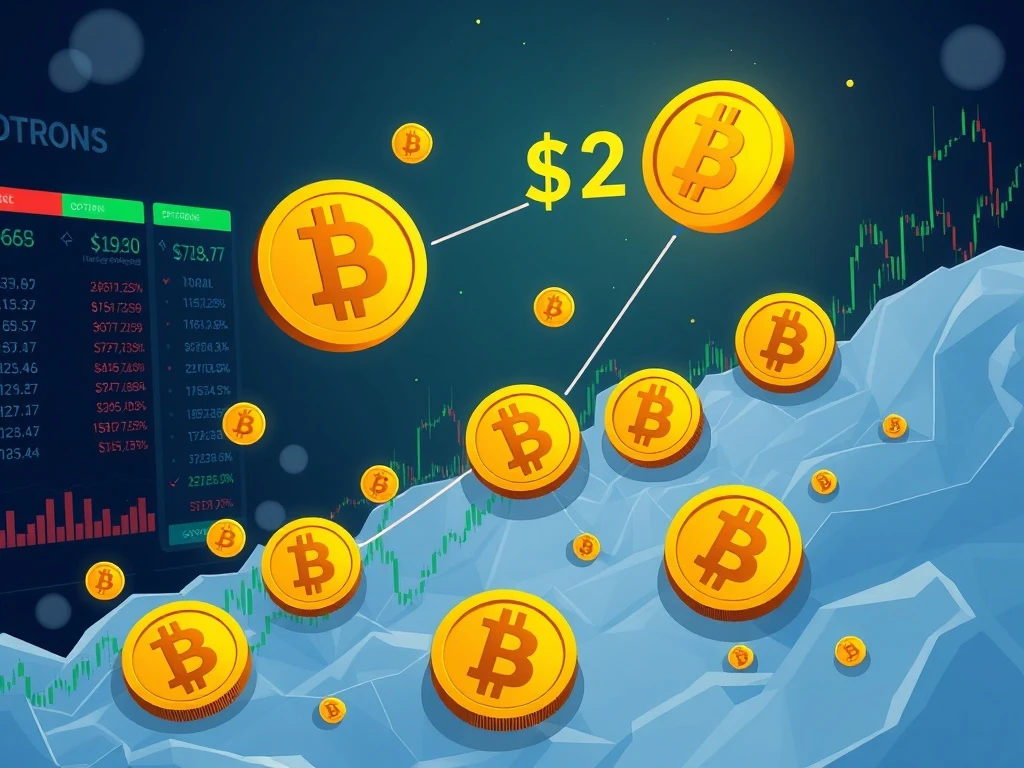Many traders are placing significant bets on a monumental surge in Bitcoin price by the year’s end. This creates a buzz, especially among those interested in the volatile world of cryptocurrency investments. However, a closer look at the underlying market data, particularly options contracts, reveals a different story about the likelihood of Bitcoin reaching the ambitious $200,000 mark.
Understanding Bitcoin Price Options and Open Interest
The cryptocurrency market, like traditional finance, utilizes derivatives to manage risk and speculate on future prices. Bitcoin options are financial contracts allowing traders to buy or sell Bitcoin at a predetermined price on or before a specific date. The open interest, which is the total number of outstanding options contracts, provides a snapshot of market sentiment and positioning.
Currently, the market anticipates a substantial year-end options expiry for Bitcoin, valued at approximately $8.8 billion, set for December 26. Over $1 billion in these options would become active if the Bitcoin price surpasses $200,000. This might suggest a widespread expectation for a massive 72% rally. However, this assumption oversimplifies the complex strategies employed by professional traders.
Call options, which grant the right to buy, currently dominate the open interest with $6.45 billion. Put options, which grant the right to sell, trail significantly at $2.36 billion. While this indicates a general bullish bias, it does not automatically translate to a direct bet on Bitcoin hitting $200,000. Interestingly, many bearish traders seem comfortable with the Bitcoin price remaining below $120,000, suggesting a nuanced market view.
The Reality Behind Aggressive Call Options
Many call options feature strike prices as high as $170,000 or even higher. These will expire worthless unless Bitcoin gains a substantial 46% from its current levels. In fact, if the Bitcoin price hovers around $116,500 on December 26, only $878 million worth of call open interest would retain value at expiry. This demonstrates the high bar for these aggressive calls to yield profit through a straightforward directional bet.
Professional traders often use highly bullish call options not for simple directional wagers but as components of more sophisticated strategies. These strategies do not necessarily depend on a direct 70% year-end rally to be profitable. They are designed to benefit from specific price movements or ranges, often with limited risk.
Sophisticated Strategies: Call Diagonal Spread
One such strategy is the **Call Diagonal Spread**. This involves simultaneously buying a long-dated call option with a high strike price (e.g., a $200,000 December call) and selling a shorter-dated call option with the same strike price but an earlier expiry (e.g., a $200,000 October call).
Consider the mechanics of this strategy:
- You purchase a December call option for $200,000.
- You sell an October call option for $200,000.
This setup yields the most profit if the Bitcoin price exceeds $146,000 by October 31. In this scenario, the long-dated call appreciates significantly while the short-term call expires worthless. Interestingly, if the Bitcoin price climbs past $200,000, this strategy can actually incur losses. The maximum potential loss for this strategy is approximately BTC 0.005 (around $585 at current prices), while the maximum gain is BTC 0.0665 (roughly $7,750). This illustrates a risk-managed approach rather than a pure directional bet on an extreme rally.

Sophisticated Strategies: Inverse Call Butterfly
Another complex strategy is the **Inverse Call Butterfly**. This involves a combination of buying and selling calls at different strike prices, all with the same expiry. Specifically, it consists of:
- Buying one $140,000 call.
- Selling two $160,000 calls.
- Buying one $200,000 call.
All these options would have December expiries. This position generates the most profit if the Bitcoin price lands near $160,000 on December 26, potentially netting BTC 0.112 (around $13,050). However, losses begin to accumulate if the Bitcoin price climbs past $178,500. Even so, the $200,000 call acts as a hedge, helping to cap potential losses. In this specific case, the maximum loss is BTC 0.109, or approximately $12,700. These examples highlight how far-out-of-the-money calls are used strategically, not as simple predictions.

Bearish Bets and Implied Probabilities for Bitcoin Price
While the focus often falls on aggressive bullish calls, it is important to note the presence of significant bearish positions. Nearly $900 million in put options are positioned between $50,000 and $80,000 for the December expiry. This indicates that bearish bets are also active in the market, even if they carry lower implied probabilities based on current market conditions.
To gauge true market sentiment, we can look at the implied probability derived from options pricing using models like Black-Scholes. For instance, a $140,000 call is currently priced around BTC 0.051 (roughly $5,940). This implies a 21% probability of the Bitcoin price reaching that level by expiry. In stark contrast, the $200,000 call trades at BTC 0.007 (about $814), reflecting an implied probability below 3%.
These figures clearly demonstrate that despite the large open interest in high-strike calls, the market assigns a very low statistical probability to the Bitcoin price hitting $200,000 by year-end. Aggressive strike prices may capture headlines, but the underlying data tells a more grounded story. Traders are not simply betting the farm on a massive 72% rally. Instead, they are using these far-out-of-the-money calls as tools within structured strategies that offer limited risk and leveraged upside, rather than as direct forecasts of an extreme price target.
Factors Influencing Bitcoin Price Beyond Options
While options data provides valuable insights into derivatives market sentiment, the actual Bitcoin price is influenced by a multitude of broader factors. These include:
- Macroeconomic Conditions: Global inflation rates, interest rate policies by central banks, and overall economic stability significantly impact investor appetite for risk assets like Bitcoin.
- Regulatory Developments: News regarding cryptocurrency regulations, ETF approvals, or bans in major economies can cause rapid price shifts.
- Technological Advancements: Updates to the Bitcoin network, such as improvements in scalability or security, can affect its perceived value.
- Institutional Adoption: Increased involvement from large financial institutions, corporations, and governments can drive demand and legitimacy.
- Market Liquidity: The overall volume of trading and ease with which Bitcoin can be bought and sold affects price stability and movement.
- Supply and Demand Dynamics: Halving events, mining difficulty, and overall investor demand directly influence the available supply and circulating demand.
Therefore, while options reveal professional positioning, they are only one piece of the puzzle in predicting the future Bitcoin price. The interplay of these diverse factors ultimately determines market direction.
Comparing Market Odds and Other Predictions for Bitcoin Price
Interestingly, platforms like Polymarket, which operate as prediction markets, offer a different perspective on the likelihood of the Bitcoin price reaching $200,000 this year. According to Polymarket, the odds of BTC price hitting $200,000 this year are higher, standing at 13%. This contrasts sharply with the under 3% implied probability from the options market. This discrepancy highlights the difference between speculative betting markets and the more conservative, risk-managed strategies seen in institutional options trading.
Prediction markets often reflect a broader public sentiment and speculative interest, whereas options markets, particularly those with large institutional participation, tend to reflect hedging strategies and more complex financial engineering. Therefore, while a 13% chance is still relatively low, it is significantly higher than the options-derived probability, suggesting that some segments of the market hold a more optimistic view, even if it is not backed by the same type of structured financial positioning.
The journey of Bitcoin price is dynamic and influenced by numerous variables. While the allure of a $200,000 Bitcoin price by year-end is captivating, market data suggests a more measured reality. Professional traders are employing sophisticated strategies that mitigate risk, rather than simply betting on a massive, straightforward rally. Understanding these nuances provides a clearer picture of market sentiment and the true probabilities involved.
Frequently Asked Questions (FAQs)
Q1: What is the difference between a call option and a put option for Bitcoin price?
A call option gives the holder the right, but not the obligation, to buy Bitcoin at a specific price (the strike price) on or before a certain date. It is typically used by traders who expect the Bitcoin price to increase. Conversely, a put option gives the holder the right, but not the obligation, to sell Bitcoin at a specific strike price on or before a certain date. It is used by traders who expect the Bitcoin price to decrease.
Q2: Why do traders use complex options strategies like diagonal or butterfly spreads instead of just buying calls?
Complex options strategies are used to manage risk, generate income, or profit from specific price movements (e.g., price remaining within a range) rather than just a simple directional move. They can reduce the cost of a position, limit potential losses, or profit from time decay, offering more nuanced ways to express a market view compared to a straightforward purchase of a call option.
Q3: What does ‘implied probability’ mean in the context of Bitcoin options?
Implied probability, derived from options pricing models like Black-Scholes, is the market’s estimate of the likelihood that an underlying asset’s price will reach a certain level (the strike price) by the option’s expiry. A lower implied probability for a high strike price suggests the market considers it less likely for the Bitcoin price to reach that level.
Q4: How reliable are predictions from platforms like Polymarket compared to options market data for Bitcoin price?
Polymarket and similar prediction markets reflect the collective bets of participants, often including retail traders and public sentiment. Options market data, especially open interest from institutional platforms, often reflects more sophisticated, risk-managed strategies and hedging by professional traders. Both offer insights, but they represent different segments of market participants and their motivations. Options data can be more indicative of institutional positioning and risk management.
Q5: What are the primary factors that influence the Bitcoin price?
The Bitcoin price is influenced by a combination of factors, including macroeconomic conditions (inflation, interest rates), regulatory news (ETF approvals, government policies), technological developments within the Bitcoin network, institutional adoption, market liquidity, and the fundamental supply and demand dynamics, such as Bitcoin halving events.






















